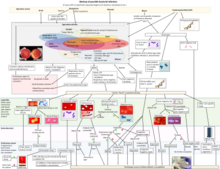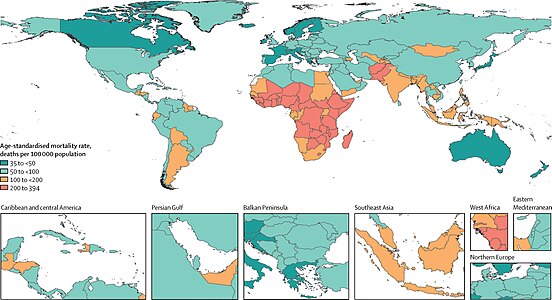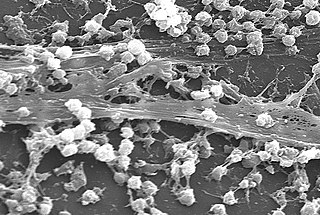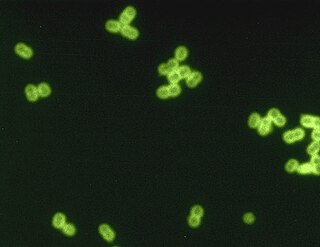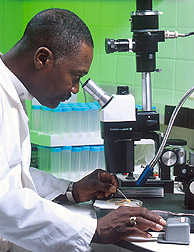| Species | Transmission | Diseases | Treatment | Prevention |
|---|
| Actinomyces israelii | Oral flora [48] | Actinomycosis: [48] painful abscesses and cysts MRSA in the mouth, lungs, [49] [50] or gastrointestinal tract. [35] | Prolonged penicillin G and drainage [48] | |
| Bacillus anthracis | Contact with cattle, sheep, goats and horses [51]
Spores enter through inhalation or through abrasions [33] | Anthrax: pulmonary, gastrointestinal and/or cutaneous symptoms. [48] | In early infection: [52]
Penicillin
Doxycycline
Ciprofloxacin
Raxibacumab [53] | Anthrax vaccine [33]
Autoclaving of equipment [33] |
| Bacteroides fragilis | Gut flora [48] | Abscesses in gastrointestinal tract, pelvic cavity and lungs [48] | metronidazole [48] | Wound care [54]
Aspiration prevention [54] |
| Bordetella pertussis | Contact with respiratory droplets expelled by infected human hosts. [33] | Whooping cough [33] [48]
Secondary bacterial pneumonia [33] | Macrolides [33] such as erythromycin, [33] [48] before paroxysmal stage [48] | Pertussis vaccine, [33] [48] such as in DPT vaccine [33] [48] |
| Borrelia | B. burgdorferi [33] [48]
B. garinii [33]
B. afzelii [33] | Ixodes hard ticks
Reservoir in mice, other small mammals, and birds [55] | Lyme disease [56] [57] | Doxycycline for adults, amoxicillin for children, ceftriaxone for neurological involvement [56] | Wearing clothing that limits skin exposure to ticks. [33]
Insect repellent. [33]
Avoid areas where ticks are found. [33] |
B. recurrentis [58]
and others [note 1] | Pediculus humanus corporis body louse (B. recurrentis only) and Ornithodoros soft ticks [58] | Relapsing fever | Penicillin, tetracycline, doxycycline [59] | Avoid areas where ticks are found [58]
Better access to washing facilities [58]
Reduce crowding [58]
Pesticides [58] |
| Brucella | B. abortus
B. canis
B. melitensis
B. suis | Direct contact with infected animal [33]
Oral, by ingestion of unpasteurized milk or milk products [33] | Brucellosis: mainly fever, muscular pain and night sweats | doxycycline [33]
streptomycin
or gentamicin [33] | |
| Campylobacter jejuni | Fecal–oral from animals (mammals and fowl) [33] [48]
Uncooked meat (especially poultry) [33] [48]
Contaminated water [33] | | Treat symptoms [33]
Fluoroquinolone [48] such as ciprofloxacin [33] in severe cases [33] | Good hygiene [33]
Avoiding contaminated water [33]
Pasteurizing milk and milk products [33]
Cooking meat (especially poultry) [33] |
| Chlamydia | C. pneumoniae | Respiratory droplets [33] [48] | Atypical pneumonia [48] | Doxycycline [33] [48]
Erythromycin [33] [48] | None [33] |
| C. trachomatis | vaginal sex [33]
oral sex [33]
anal sex [33] Vertical from mother to newborn(ICN) [33]
Direct or contaminated surfaces and flies (trachoma) [33] | Trachoma [33] [48]
Neonatal conjunctivitis [33] [48]
Neonatal pneumonia [33] [48]
Nongonococcal urethritis (NGU) [33] [48]
Urethritis [33] [48]
Pelvic inflammatory disease [33] [48]
Epididymitis [33] [48]
Prostatitis [33] [48]
Lymphogranuloma venereum (LGV) [33] [48] | Erythromycin [33] [48]
(adults) [48] Doxycycline [33] [48]
(infants and pregnant women) [48] | Erythromycin or silver nitrate in newborn's eyes [33]
Safe sex [33]
Abstinence [33] |
| Chlamydophila psittaci | Inhalation of dust with secretions or feces from birds (e.g. parrots) | Psittacosis, mainly atypical pneumonia | Tetracycline [33]
Doxycycline [33]
Erythromycin [33] | - |
| Clostridium | C. botulinum | Spores from soil, [33] [48] persevere in canned food, smoked fish and honey [48] | Botulism: Mainly muscle weakness and paralysis [48] | Antitoxin [33] [48]
Penicillin [48]
Hyperbaric oxygen [48]
Mechanical ventilation [48] | Proper food preservation techniques |
| C. difficile | Gut flora, [33] [48] overgrowing when other flora is depleted [33] | Pseudomembranous colitis [33] [48] | Discontinuing responsible antibiotic [33] [48]
Vancomycin or metronidazole if severe [33] [48] | Fecal bacteriotherapy |
| C. perfringens | Spores in soil [33] [48]
Vaginal flora and gut flora [33] | Anaerobic cellulitis [33] [48]
Gas gangrene [33] [48] Acute food poisoning [33] [48] | Gas gangrene: Debridement or amputation [33] [48]
Hyperbaric medicine [33] [48]
High doses of doxycycline [33] or penicillin G [33] [48] and clindamycin [48]
Food poisoning: Supportive care is sufficient [33] | Appropriate food handling [33] |
| C. tetani | Spores in soil, skin penetration through wounds [33] [48] | Tetanus: muscle spasms [60] | Tetanus immune globulin [33] [48] Sedatives [33]
Muscle relaxants [33]
Mechanical ventilation [33] [48]
Penicillin or metronidazole [48] | Tetanus vaccine (such as in the DPT vaccine) [33] |
| Corynebacterium diphtheriae | respiratory droplets
part of human flora | Diphtheria: Fever, sore throat and neck swelling, potentially narrowing airways. [61] | Horse serum antitoxin
Erythromycin
Penicillin | DPT vaccine |
| Ehrlichia | E. canis [48]
E. chaffeensis [48] | Dog tick [48] | Ehrlichiosis: [48] headache, muscle aches, and fatigue | |
| Enterococcus | E. faecalis
E. faecium | Part of gut flora, [48] opportunistic or entering through GI tract or urinary system wounds [33] | Bacterial endocarditis, [48] biliary tract infections, [48] urinary tract infections [48] | Ampicillin (combined with aminoglycoside in endocarditis) [48] Vancomycin [33] | No vaccine Hand washing and other nosocomial prevention |
| Escherichia | E. coli (generally) | | | UTI: [33] (resistance-tests are required first) Meningitis: [33] Diarrhea: [33] - Antibiotics above shorten duration
- Electrolyte and fluid replacement
| (no vaccine or preventive drug) [33] |
| Enterotoxigenic E. coli (ETEC) | | |
| Enteropathogenic E. coli | | |
| Enteroinvasive E.coli (EIEC) | | |
| Enterohemorrhagic (EHEC), including E. coli O157:H7 | | |
| Francisella tularensis | - vector-borne by arthropods [33]
- Infected wild or domestic animals, birds or house pets [33]
| Tularemia: Fever, ulceration at entry site and/or lymphadenopathy. [63] Can cause severe pneumonia. [63] | | - Avoiding insect vectors [33]
- Precautions when handling wild animals or animal products [33]
|
| Haemophilus influenzae | - Droplet contact [33]
- Human flora of e.g. upper respiratory tract [33]
| | Meningitis: [33] (resistance-tests are required first) | |
| Helicobacter pylori | - Colonizing stomach [33]
- Unclear person-to-person transmission [33]
| | | (No vaccine or preventive drug) [33] |
| Klebsiella pneumoniae | | | | |
| Legionella pneumophila | | | | (no vaccine or preventive drug) [33] Heating water [33] |
| Leptospira species | - Food and water contaminated by urine from infected wild or domestic animals. Leptospira survives for weeks in fresh water and moist soil. [33]
| | | Vaccine not widely used [33] Prevention of exposure [33] |
| Listeria monocytogenes | |
| | (no vaccine) [33] - Proper food preparation and handling [33]
|
| Mycobacterium | M. leprae | - Prolonged human-human contact, e.g. through exudates from skin lesions to abrasion of other person [33]
| | Tuberculoid form: Lepromatous form: | |
| M. tuberculosis | | | (difficult, see Tuberculosis treatment for more details) [33] Standard "short" course: [33] - First 2 months, combination:
- Further 4 months, combination:
| |
| Mycoplasma pneumoniae | | | | |
| Neisseria | N. gonorrhoeae | |
| Uncomplicated gonorrhea: [33] Ophthalmia neonatorum: | (No vaccine) [33] |
| N. meningitidis | | | | |
| Pseudomonas aeruginosa | Opportunistic; [48] Infects damaged tissues or people with immunodeficiency. [33] | Pseudomonas infection: [33] | | (no vaccine) [33] |
| Nocardia asteroides | In soil [48] | Nocardiosis: [48] Pneumonia, endocarditis, keratitis, neurological or lymphocutaneous infection | TMP/SMX [48] | |
| Rickettsia rickettsii | | | | (no preventive drug or approved vaccine) [33] |
| Salmonella | S typhi | | | | |
| Other Salmonella species
e.g. S. typhimurium [33]
| - Fecal–oral [33]
- Food contaminated by fowl [33] (e.g. uncooked eggs) [48] or turtles [48]
| |
| (No vaccine or preventive drug) [33] - Proper sewage disposal [33]
- Food preparation [33]
- Good personal hygiene [33]
|
| Shigella | S. sonnei [33]
S. dysenteriae [48]
| | | | - Protection of water and food supplies [33]
- Vaccines are in trial stage [71]
|
| Staphylococcus | aureus | | Coagulase-positive staphylococcal infections: | | (no vaccine or preventive drug) - Barrier precautions, washing hands and fomite disinfection in hospitals
|
| epidermidis | Human flora in skin, [33] [48] anterior nares [33] and mucous membranes [48] | | | None [33] |
| saprophyticus | Part of normal vaginal flora [33] | | | None [33] |
| Streptococcus | agalactiae | Human flora in vagina, [33] [48] urethral mucous membranes, [33] rectum [33] | | | None [33] |
| pneumoniae | | | | - 23-serotype vaccine for adults (PPV) [33] [48]
- Heptavalent conjugated vaccine for children (PCV) [33]
|
| pyogenes | | | | No vaccine [33] - Rapid antibiotic treatment helps prevent rheumatic fever [33]
|
| viridans | Oral flora, [48] penetration through abrasions | | Penicillin G [48] | |
| Treponema pallidum subspecies pallidum | | | | - Penicillin offered to recent sexual partners [75]
- Antibiotics to pregnant women if risk of transmitting to child [33]
- No vaccine available [33]
- Safe sex [33]
|
| Vibrio cholerae | | | | |
| Yersinia pestis | | Plague: | | | |





